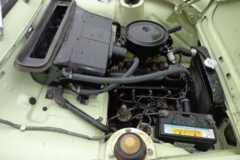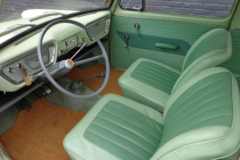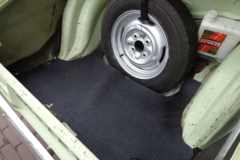In the aftermath of the Second World War, the English Ford was forced to continue embroidering on the pre-war models for a long time. That was because the company, the country, took a long time to recover after that war. But in 1959 Ford reinvented itself. Because then Ford of England presented its first 'modern' car, the first streamlined English Ford, The Ford Anglia 105E. The new Ford was modern and had something that really set it apart from the rest of the market: The 'wrong way around' sloping rear window.
The car reinvented
While the debris from the bombed factories had not even been cleared away, the car manufacturers, not just Ford, started developing new, modern cars very hard. But before they could be made, a whole new infrastructure had to be built up. The Ford Anglia was one of those new cars. But traditionally, its roots were already in the time before WWII. The pre-war Ford series had already included the car that was the ancestor of the first generation of Anglias presented in 1949. The first Anglias were therefore still 'pre-war'.
That car got a 'make over' with new looks in 1953 and from that moment on was the Ford Anglia 100E. But the icing on the cake? That was the Ford Anglia 1959E presented in 105, so with that diamond.
Conservative technology
Now that Ford Anglia 105E looked modern, but under the hood still the best dated 1172 cc 30 pk side valve from its predecessor, the Ford Anglia 100E. To make the newcomer completely up to date, he was given a newly developed head valve motor. With a displacement of 997 cc, it was somewhat smaller than the old, endearing steam engine, but the new block did deliver 10 hp more. (40 pk at 5.000 rpm). That new engine was not afraid to turn a bit more and turned the Ford Anglia into a tough car.
The flames in 1962 went out for the side flaps. It was replaced by a long-stroke head valve motor with a cylinder capacity of 1200 cc. And that powerhouse delivered a hair after 50 hp at 4.800 rpm. That new block made the Ford Anglia an even more serious car. The minus in the story was in the suspension and damping of the car. Entirely British in nature, it was just the same as that of the Ford Anglia 100E, the clearly dated predecessor. The power sources were okay. But the handling and comfort clearly suffered as a result of the decision to leave everything the old as regards suspension and damping. But later game successes - in races and rallies, Anglia's very strong players in their class - proved that here too the soup was not eaten as hot as it was served.
Very interesting that technique
But with what did the new Ford Anglia create a furore? How did the new Ford stand out from the crowd? That was with his body. The rear-inclined rear window gave the Ford a unique appearance. The idea behind the negatively sloping rear window was that the headroom for the rear passengers turned out much better this way. The fact that the window remained nice and clean due to its placement was a nice bonus.
They all rusted
An investigation is currently underway as to whether new cars are made more susceptible (on purpose) to rust, because sustainability should of course not be at the expense of production. But I still convinced the construction time of the Anglia's rusted cars. So also the Anglias. That is why such a Ford Anglia is now quite a rare classic.










I have owned an Anglia 12e for 105 years myself.
Sent right.
I updated the rust spots here and there.
Have fun with it.
I had one once, sometime in the early 70's. It was indeed not good in terms of rust (I looked through the bottom in some places, there was no MOT yet), and there was no starter motor in it. It was killed, I had no money for a new one. I preferred to park the car on a sloping road, so that the engine would start automatically when I let it roll down. Or, if I was on the road for a longer ride and taking a break, I just let it walk. Or I put it in freewheel, pushed it forward and jumped in, quickly put it in 2nd gear and hoped it would catch on. Fortunately, that almost always happened ...
My then girlfriend, and still my current wife, could hardly imagine meeting a friend who had his own car! I went with her from Groningen to Maastricht for a friend's wedding in the Ford Anglia without a starter motor. We made it and we came back ...
Since I was hit by an Anglia 12 on my bike in Arnhemse Parkstraat as a 105 year old boy, I hate those things! Mister was looking for the red light district it turned out later when my parents were there, because he wanted to arrange it without the police and insurance. Unfortunately the ambulance came and the police officer followed closely ...
So for me never an Anglia again!
Got my driver's license in an Anglia in 1961 as an 18-year-old. Then rented one several times. For that time quite a good car at least in my memory.